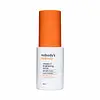What's inside
What's inside
 Key Ingredients
Key Ingredients

 Benefits
Benefits

 Concerns
Concerns

 Ingredients Side-by-side
Ingredients Side-by-side

Water
Skin ConditioningBrassica Campestris Seed Oil
Skin ConditioningGlycerin
HumectantC14-22 Alcohols
Emulsion StabilisingButyrospermum Parkii Butter
Skin ConditioningHydroxyethyl Acrylate/Sodium Acryloyldimethyl Taurate Copolymer
Emulsion StabilisingAscorbic Acid
AntioxidantSodium Ascorbyl Phosphate
AntioxidantZingiber Officinale Root Extract
MaskingHyaluronic Acid
HumectantVolcanic Soil
Skin ConditioningCitrus Sinensis Peel Oil Expressed
PerfumingCitrus Limon Peel Oil
MaskingCitrus Paradisi Peel Oil
MaskingOenothera Biennis Oil
EmollientCoco-Caprylate/Caprate
EmollientCaprylic/Capric Triglyceride
MaskingC12-20 Alkyl Glucoside
EmulsifyingXanthan Gum
EmulsifyingCaprylyl Glycol
EmollientGlucose
HumectantAmylopectin
Sorbitan Isostearate
EmulsifyingPolysorbate 60
Emulsifying1,2-Hexanediol
Skin ConditioningEthylhexylglycerin
Skin ConditioningPhenoxyethanol
PreservativeSodium Hydroxide
BufferingCitric Acid
BufferingLimonene
PerfumingLinalool
PerfumingCitral
PerfumingWater, Brassica Campestris Seed Oil, Glycerin, C14-22 Alcohols, Butyrospermum Parkii Butter, Hydroxyethyl Acrylate/Sodium Acryloyldimethyl Taurate Copolymer, Ascorbic Acid, Sodium Ascorbyl Phosphate, Zingiber Officinale Root Extract, Hyaluronic Acid, Volcanic Soil, Citrus Sinensis Peel Oil Expressed, Citrus Limon Peel Oil, Citrus Paradisi Peel Oil, Oenothera Biennis Oil, Coco-Caprylate/Caprate, Caprylic/Capric Triglyceride, C12-20 Alkyl Glucoside, Xanthan Gum, Caprylyl Glycol, Glucose, Amylopectin, Sorbitan Isostearate, Polysorbate 60, 1,2-Hexanediol, Ethylhexylglycerin, Phenoxyethanol, Sodium Hydroxide, Citric Acid, Limonene, Linalool, Citral
Ingredients Explained
These ingredients are found in both products.
Ingredients higher up in an ingredient list are typically present in a larger amount.
Caprylyl Glycol is a humectant and emollient, meaning it attracts and preserves moisture.
It is a common ingredient in many products, especially those designed to hydrate skin. The primary benefits are retaining moisture, skin softening, and promoting a healthy skin barrier.
Though Caprylyl Glycol is an alcohol derived from fatty acids, it is not the kind that can dry out skin.
This ingredient is also used as a preservative to extend the life of products. It has slight antimicrobial properties.
Learn more about Caprylyl GlycolGlycerin is already naturally found in your skin. It helps moisturize and protect your skin.
A study from 2016 found glycerin to be more effective as a humectant than AHAs and hyaluronic acid.
As a humectant, it helps the skin stay hydrated by pulling moisture to your skin. The low molecular weight of glycerin allows it to pull moisture into the deeper layers of your skin.
Hydrated skin improves your skin barrier; Your skin barrier helps protect against irritants and bacteria.
Glycerin has also been found to have antimicrobial and antiviral properties. Due to these properties, glycerin is often used in wound and burn treatments.
In cosmetics, glycerin is usually derived from plants such as soybean or palm. However, it can also be sourced from animals, such as tallow or animal fat.
This ingredient is organic, colorless, odorless, and non-toxic.
Glycerin is the name for this ingredient in American English. British English uses Glycerol/Glycerine.
Learn more about GlycerinHyaluronic acid is naturally found in healthy skin. It is a humectant, meaning it draws moisture to your skin.
This ingredient helps hydrate, soothe, and protect the skin.
What makes hyaluronic acid so hydrating? It has the capacity to bind or hold large amounts of water.
Fun fact: It is already naturally found in our bodies, such as the fluids of our eyes and our joints.
Studies find this ingredient to have anti-inflammatory and anti-microbial properties. This can help speed up wound-healing.
Hyaluronic acid can be irritating if the molecule has a low-molecular weight, or if the molecules are small.
One study found low-molecular weight hyaluronic acid to be pro-inflammatory, meaning some people may experience irritation. This is because our bodies use hyaluronic acid in the wound-healing process to signal to our bodies, via irritation, that something needs healing.
The same study found high-molecular weight hyaluronic acid to be anti-inflammatory.
These are some other common types of Hyaluronic Acid:
Learn more about Hyaluronic AcidPhenoxyethanol is a preservative that has germicide, antimicrobial, and aromatic properties. Studies show that phenoxyethanol can prevent microbial growth. By itself, it has a scent that is similar to that of a rose.
It's often used in formulations along with Caprylyl Glycol to preserve the shelf life of products.
Water. It's the most common cosmetic ingredient of all. You'll usually see it at the top of ingredient lists, meaning that it makes up the largest part of the product.
So why is it so popular? Water most often acts as a solvent - this means that it helps dissolve other ingredients into the formulation.
You'll also recognize water as that liquid we all need to stay alive. If you see this, drink a glass of water. Stay hydrated!
Learn more about WaterXanthan gum is used as a stabilizer and thickener within cosmetic products. It helps give products a sticky, thick feeling - preventing them from being too runny.
On the technical side of things, xanthan gum is a polysaccharide - a combination consisting of multiple sugar molecules bonded together.
Xanthan gum is a pretty common and great ingredient. It is a natural, non-toxic, non-irritating ingredient that is also commonly used in food products.
Learn more about Xanthan Gum